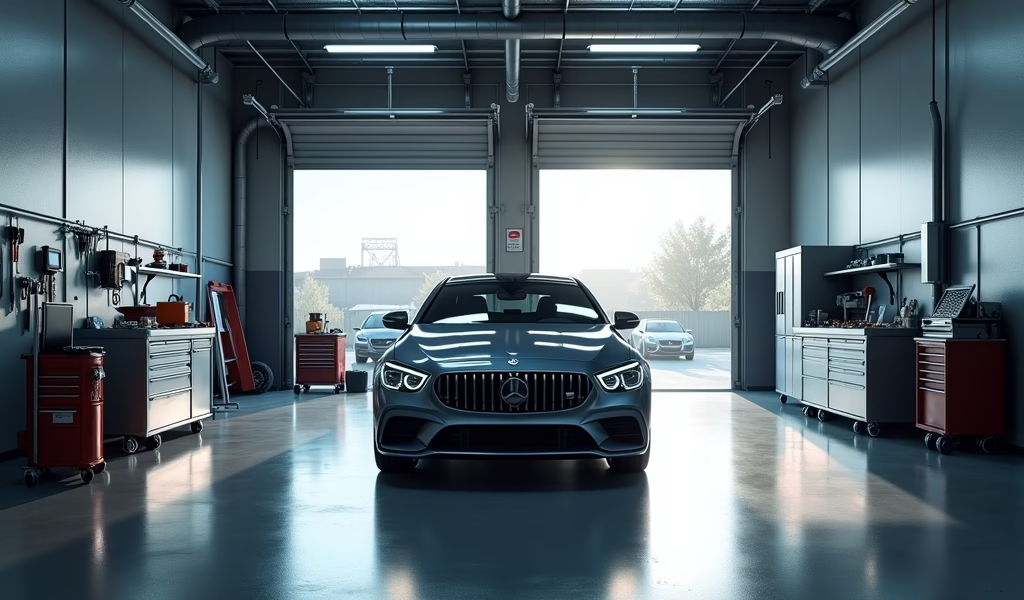Overview
This guide offers five essential strategies for maintaining leased vehicles to avoid end-of-lease penalties: following manufacturer maintenance schedules, addressing minor issues promptly, maintaining appearance inside and out, monitoring mileage limits, and documenting all maintenance and condition records. By implementing these practices, lessees can protect themselves financially, ensure a stress-free lease return, and potentially qualify for better terms on future leases.
Table of Contents
- Introduction to Leasing: The Smart Driver’s Choice
- Why Proper Maintenance Matters for Leased Vehicles
- Tip 1: Follow the Manufacturer’s Maintenance Schedule
- Tip 2: Address Minor Issues Before They Escalate
- Tip 3: Keep That Showroom Shine Inside and Out
- Tip 4: Watch Your Mileage Like a Hawk
- Tip 5: Document Everything—Your Financial Shield
- Conclusion: Mastering Your Lease Experience
- Frequently Asked Questions
Introduction to Leasing: The Smart Driver’s Choice
Leasing has become the go-to option for savvy drivers who want that new-car experience without the long-term commitment. As someone who’s spent 20 years under the hood and guiding customers through their vehicle decisions, I’ve seen leasing grow from a niche option to nearly one-third of all new vehicle transactions. Finding the best car to lease and maintaining it properly isn’t just about enjoying your ride—it’s about protecting your wallet when turn-in time arrives.
When you lease a vehicle, you’re essentially borrowing it with a promise to return it in good condition. That temporary custody comes with specific responsibilities that, if neglected, can lead to eye-watering end-of-lease fees. I’ve seen customers hit with charges that exceeded $2,000 simply because they didn’t understand proper lease care.
In this guide, I’ll walk you through five essential care strategies I’ve developed over decades of working with leased vehicles. These tips will help you maintain your vehicle properly, avoid unnecessary charges, and enjoy a worry-free driving experience with zero unwanted surprises at the end of your term.
Why Proper Maintenance Matters for Leased Vehicles
Think of your lease agreement as a promise between you and the leasing company. They provide you with a pristine vehicle, and you agree to return it in similar condition, accounting only for reasonable wear and tear. Those lease documents aren’t just paperwork—they’re detailed maintenance contracts outlining your responsibilities.
Most people don’t realize that lease agreements contain specific language about maintenance requirements. Skip those oil changes or ignore manufacturer service intervals, and you’re not just risking mechanical issues—you’re potentially violating your contract.
When lease-end arrives, your vehicle undergoes a thorough inspection that would make a drill sergeant proud. Those neglected maintenance items suddenly transform into financial penalties that add up quickly. I’ve watched customers face charges ranging from $350 for missed oil changes to over $3,000 for more serious neglect.
Beyond avoiding fees, proper maintenance preserves the vehicle’s value throughout your lease. This matters because your monthly payments are calculated based on the projected residual value. By maintaining the vehicle properly, you’re protecting both your driving experience and the foundation of your leasing agreement, potentially qualifying you for better lease terms next time around.

Tip 1: Follow the Manufacturer’s Maintenance Schedule
Your vehicle’s maintenance schedule isn’t a casual suggestion—it’s a precisely engineered roadmap created by the people who designed your vehicle. As a master technician who’s worked on thousands of cars, I can tell you that following this schedule is the single most important thing you can do for your leased vehicle.
Key maintenance milestones typically include:
- Oil changes (generally every 5,000-7,500 miles for conventional oil, 7,500-10,000 for synthetic)
- Tire rotations (every 5,000-7,500 miles)
- Air filter replacements (usually every 15,000-30,000 miles)
- Fluid checks and replacements (transmission, brake, power steering)
- Brake inspections (typically every 10,000 miles)
Modern vehicles make tracking these intervals easier with dashboard maintenance reminders, but don’t rely solely on these. I recommend creating a dedicated maintenance calendar or using a service tracking app. My customers who keep the most meticulous records tend to have the smoothest lease returns.
After each service, collect detailed documentation showing exactly what was performed. Store these records either physically in a dedicated folder or digitally using cloud storage. This paper trail isn’t just good organization—it’s your insurance policy against disputes at lease-end.
The consequences of skipping scheduled maintenance can be severe. Beyond potential mechanical failures, missed maintenance often voids warranty coverage—particularly troubling for leased vehicles. Additionally, lease agreements typically require proof of maintenance compliance, and failure to provide documentation can result in penalties when you return the vehicle.
I’ve seen countless customers face unnecessary charges because they couldn’t prove they had maintained their vehicles according to schedule. One customer was charged $750 for “engine neglect” despite having changed the oil regularly—they just couldn’t produce the records to prove it. Don’t let documentation become your Achilles’ heel.
Tip 2: Address Minor Issues Before They Escalate
After 20 years of turning wrenches, I can tell you with absolute certainty: small problems rarely stay small. That check engine light, unusual sound, or slight vibration is your vehicle’s way of whispering that something needs attention. Ignoring these early warnings is like ignoring a small leak in your roof—eventually, you’ll be dealing with a much bigger, more expensive problem.
Be vigilant for these common early warning signs:
- New or unusual noises (squealing, grinding, clicking, knocking)
- Warning lights on your dashboard
- Changes in driving performance or handling
- Fluid leaks or spots under the vehicle
- Reduced fuel efficiency
- Vibrations or pulling to one side
The financial wisdom of early intervention is clear as day. A minor brake pad replacement might cost $150-300, while letting it progress to damaged rotors could quadruple that amount. I once had a customer ignore a small oil leak until it caused engine damage exceeding $3,500—far more than their lease’s value.
When issues arise, determining whether to contact the dealership or handle it yourself depends on several factors. Generally, anything covered under warranty should go straight to the dealership. For minor matters like bulb replacements or wiper blade changes, DIY approaches work fine. However, any issue affecting vehicle systems, safety components, or requiring specialized tools should be handled by professionals.
Remember that minimal upfront investment in addressing small issues can save you substantial money down the road. I’ve helped many customers avoid lease-end penalties by catching and fixing minor issues before they became major headaches.
Tip 3: Keep That Showroom Shine Inside and Out
Your leased vehicle’s appearance tells a story—make it one of care rather than neglect. As someone who’s conducted thousands of pre-return inspections, I can tell you that appearance matters tremendously during lease-end evaluations.
For exterior care, establish a regular cleaning schedule. In normal conditions, washing every two weeks helps prevent dirt and contaminants from damaging your paint. In harsh environments (coastal areas with salt air, regions with heavy road salt usage, or areas with high industrial fallout), weekly washing becomes necessary.
Consider these exterior maintenance recommendations:
- Hand-washing with automotive-specific soap (household detergents strip protective waxes)
- Quarterly waxing to protect paint and clear coat
- Immediate removal of bird droppings, tree sap, and other corrosive substances
- Parking in garages or shaded areas when possible to prevent UV damage
- Prompt touch-up of minor paint chips to prevent rust formation
Interior care is equally important. Lease-end inspectors pay close attention to cabin condition, and excessive wear or damage can trigger substantial charges. I recommend these interior maintenance practices:
- Vacuum upholstery and carpets weekly
- Clean spills immediately to prevent staining
- Use manufacturer-approved cleaners for dashboard and trim
- Protect leather surfaces with appropriate conditioners every 3-4 months
- Use seat protectors if you frequently transport children or pets
- Consider all-weather floor mats to protect against dirt and moisture
Stick with manufacturer-approved cleaners, pH-balanced soaps, high-quality microfiber cloths, and appropriate protectants. Avoid household cleaners, ammonia-based products, and abrasive compounds that can damage surfaces. I’ve seen customers charged $200+ for dashboard cracks caused by using the wrong cleaning products.
The seasonal elements pose particular challenges. In winter, frequent washing helps remove corrosive road salt. In summer, regular waxing provides protection against intense UV exposure. By adapting your care routine to seasonal challenges, you’ll maintain your vehicle’s showroom shine throughout the lease term and avoid those pesky appearance-related charges at turn-in.

Tip 4: Watch Your Mileage Like a Hawk
Mileage limitations in lease agreements are like speed limits on highways—exceeding them comes with consequences. Having reviewed thousands of lease returns, I can tell you that mileage overages are among the most common and costly lease-end charges.
Most leases include annual mileage allowances ranging from 10,000 to 15,000 miles, with overage charges typically between $0.15 and $0.30 per extra mile. This might seem insignificant until you calculate that exceeding your limit by just 5,000 miles could result in an additional $750-$1,500 charge. I’ve seen customers face mileage overage bills exceeding $3,000—more than the value of their down payment!
Understanding your driving patterns is crucial for mileage management. Consider these strategies to stay within your allotted mileage:
- Calculate your monthly mileage allowance (annual limit divided by 12)
- Track your mileage weekly using a dedicated app or logbook
- Identify opportunities for carpooling or public transportation
- Consolidate errands to reduce unnecessary trips
- Consider alternatives like bicycling or walking for short distances
- Use mapping apps to find shorter routes for regular destinations
If you consistently monitor your mileage and notice you’re trending toward exceeding your limit, you have several options. Some leasing companies allow you to purchase additional miles upfront at a discounted rate compared to end-of-lease charges. For example, buying miles in advance might cost $0.10-$0.15 per mile versus $0.25-$0.30 at lease-end—a significant savings.
Alternatively, you might negotiate a mileage adjustment mid-lease, though this typically results in increased monthly payments. For those approaching their mileage limit near the end of their lease term, early lease termination or trading for a new lease might prove more economical than paying substantial overage charges.
I’ve seen customers save thousands by making strategic decisions about their lease based on careful mileage tracking. One client switched to public transportation for his commute after realizing he was on pace to exceed his mileage by 12,000 miles, saving approximately $3,600 in potential charges. Smart mileage management is one of the most impactful ways to protect yourself financially during your lease.
Tip 5: Document Everything—Your Financial Shield
In my decades working with leased vehicles, I’ve seen one factor repeatedly separate stress-free lease returns from expensive nightmares: documentation. Think of your documentation as creating an indisputable historical record of your responsible stewardship—it’s your strongest ally and best defense.
Start by creating a comprehensive maintenance file that includes:
- All service records and receipts
- Repair documentation
- Car wash and detailing receipts
- Before-and-after photos of any minor damage and repairs
- Notes about conversations with the leasing company regarding the vehicle
Visually documenting your vehicle’s condition throughout the lease term provides invaluable protection. Take detailed photographs when you first receive the vehicle, capturing both exterior and interior from multiple angles. Document any existing scratches, dents, or interior wear. I recommend updating this visual record quarterly and after any significant events (accidents, repairs, or weather damage).
Digital tools have revolutionized maintenance tracking. Smartphone apps like AUTOsist, Car Maintenance Reminder, and Drivvo allow you to store service records, set maintenance reminders, and track expenses. Cloud storage services ensure your documentation remains accessible even if your phone is lost or damaged.
This meticulous documentation serves two crucial purposes: it demonstrates your compliance with lease requirements and provides evidence should any disputes arise at lease-end. I’ve helped many customers avoid hundreds or even thousands in charges by presenting thorough documentation during the lease-return inspection.
One customer faced a $450 charge for a small door ding that was present when she received the vehicle. Her careful documentation—including dated photos from the day she took delivery—resulted in the charge being waived entirely. Another client avoided $1,200 in “deferred maintenance” charges by producing complete service records showing every recommended service had been performed on schedule.
Remember that in lease disputes, the burden of proof typically falls on you as the lessee. Without documentation, it’s your word against theirs—and the leasing company holds most of the cards. Documentation is your equalizer, and in my experience, well-documented lessees almost always come out ahead.
Conclusion: Mastering Your Lease Experience
Finding the best car to lease is only half the battle—knowing how to care for it properly is what makes the difference between a rewarding lease experience and a financial headache. Throughout my career working with vehicles, I’ve seen that those who apply these five essential care strategies consistently enjoy stress-free lease returns.
By following the manufacturer’s maintenance schedule, addressing minor issues promptly, maintaining appearance, monitoring mileage, and documenting everything, you create a harmonious relationship with your leased vehicle. These aren’t just recommendations—they’re proven strategies that have saved my customers thousands of dollars in potential lease-end charges.
Responsible leasing isn’t just financially prudent—it contributes to a more sustainable automotive ecosystem by ensuring vehicles remain in excellent condition throughout their lifecycle. It also positions you for better deals on future leases since many companies offer loyalty incentives to customers who demonstrate proper vehicle care.
Remember that your leased vehicle represents both transportation and a financial commitment. By treating it with the care it deserves, you’ll enjoy not only a better driving experience but also peace of mind knowing you’re protected when lease-end arrives. That’s something I’ve seen make a meaningful difference for thousands of drivers over my years in this industry.
Frequently Asked Questions
What is the best car to lease for minimal maintenance?
Toyota, Lexus, and Honda models consistently rank highest for reliability and lowest maintenance costs. These brands typically require fewer unexpected repairs during a standard 3-year lease term.
Can I modify my leased vehicle with aftermarket parts?
Most lease agreements prohibit permanent modifications and require the vehicle to be returned to original condition. Temporary modifications that leave no damage or alterations when removed are generally acceptable.
How often should I have my leased vehicle serviced?
Follow the manufacturer’s recommended service schedule in your owner’s manual, not generic advice. Most modern vehicles require service every 5,000-10,000 miles, depending on the model and driving conditions.
What happens if I exceed my mileage limit dramatically?
Significant mileage overages can result in charges of thousands of dollars at lease-end. If you’re substantially over your limit, consider purchasing the vehicle or negotiating an early termination to minimize financial impact.
Is it worth paying for the dealer’s appearance protection packages on a leased vehicle?
Dealer-offered protection packages can be worthwhile for leased vehicles, especially if you have children or pets. However, compare their cost against the potential lease-end charges they might prevent before deciding.


Pingback: New Estate Cars for Sale: 7 Proven Tips - knowsyourcar.com